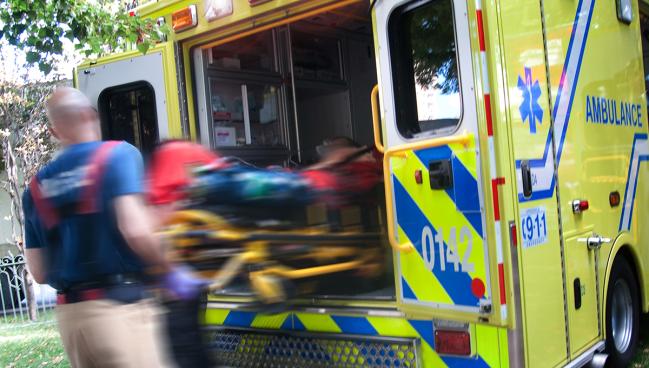Many STEMI Patients Not Treated Within National Time Goals
Prompt reperfusion is the best treatment possible, so it’s time to rededicate efforts toward speedy care, experts say.

When it comes to getting STEMI patients treated quickly, US hospital systems appear to be falling short in recent years, according to an analysis of the Get With The Guidelines Coronary Artery Disease (GWTG-CAD) registry.
Specifically, there appear to be delays when it comes to bringing STEMI patients in with emergency medical services (EMS) and in transferring patients to PCI-capable hospitals. For example, researchers found that coronary cath labs were frequently not activated within 20 minutes of evaluation by EMS and only 17% of patients were treated within 120 minutes if they required transfer to a PCI-capable hospital.
“The transferring piece is probably the most concerning of all,” lead investigator James Jollis, MD (Lindner Center for Research and Education, Cincinnati, OH), told TCTMD. “It’s always been a challenge for our healthcare systems to get someone from one hospital to another.”
Christopher Granger, MD (Duke Clinical Research Institute, Durham, NC), a co-author, agreed. “This study exposes the ongoing, and perhaps worsening, problem that we have, which is when patients are transferred from a hospital without PCI to one with PCI, the delays are too long,” he told TCTMD. “We need to either substantially improve this or consider alternative reperfusion strategies,” such as a pharmacologic strategy.
For Jollis, the new findings represent a “giant opportunity” and a chance for a “reconstituted effort,” one that would involve hospital systems regularly reviewing their data to ensure they’re treating patients within the recommended time frame. “If you turn off the effort, you may go backwards and we need to go forward again,” he said.
The American College of Cardiology and the American Heart Association (ACC/AHA) first recommended a door-to-balloon time of less than 90 minutes for STEMI patients nearly two decades ago. That recommendation is based on a wealth of data showing that timely reperfusion is an important lifesaving treatment in STEMI patients. Over the years, treatment times have been the focus of a number of quality-improvement initiatives to ensure patients were reperfused in a prompt manner, including national programs such as the AHA’s Mission: Lifeline.
The US guidelines also strongly recommend (class 1) that all communities develop and implement systems of care to ensure timely reperfusion. These systems should include a process for prehospital STEMI identification and activation, destination protocols for PCI hospitals, and transfer protocols for those who arrive at non-PCI hospitals, say experts.
Spanning Some COVID-19 Years
The new study, published online November 6, 2022, in JAMA, spans from the second quarter of 2018 to the third quarter of 2021 and includes 114,871 patients (median age 63 years; 71% men) from 601 hospitals. Of these, 57,303 arrived at hospital via EMS, 32,483 presented directly to hospital, and 25,085 were transferred to a PCI-capable hospital. Starting in 2020 when COVID-19 was included as a patient descriptor, SARS-CoV-2 infection at admission or during hospitalization was noted in 0.2% of patients in the second and third quarters. Infection peaked at 0.7% in early 2021.
Overall, 19.7% of patients were flagged as having a specific, registry-defined reason for treatment delay, the most common being cardiac arrest and/or need for intubation (6.8%). Difficulties crossing the culprit lesion (3.8%), difficulties with vascular access (2.5%), need for additional personal protective equipment (3.0%), and “other” (5.8%) were the reasons most frequently cited for these delays.
The time from first medical contact to lab activation was more than 20 minutes for most EMS-presenting patients. For those who presented to a PCI-capable hospital via EMS, the median time from symptom onset to PCI was 148 minutes (interquartile range [IQR] 111-226 minutes). For those who walked into a PCI-capable center and those who required transfer to a PCI-capable site, the median times from symptom onset to intervention were 195 and 240 minutes (IQRs 127-349 and 166-402 minutes, respectively).
The researchers stratified hospitals according to whether they were able to successfully treat 75% of patients according to the target times. For those presenting to hospital via EMS, the target was first medical contact to activation of the cath lab within 20 minutes. If hospital transfer was required, the target time was 120 minutes or less from arrival at the first hospital to stenting at the PCI-capable hospital. For those who presented directly to the hospital, the time-based metric was time from arrival to ECG of 10 minutes or less.
All patients who were treated within the goals had a significantly lower risk of in-hospital mortality—ranging from 46% to 60% lower—when compared with those who were not treated within the time windows. The mortality findings are confounded because higher-risk patients with complications are more likely to experience delays, but the results do emphasize the importance of speed when it comes to coronary reperfusion, the researchers say.
Both Jollis and Granger stressed the need for healthcare systems to “rededicate” efforts to cut treatment times for STEMI. “Most of our work has been in applying therapies that we know work,” said Jollis. “We think you can save more lives doing that [versus] making new discoveries.”
Applying Therapies That Work
Brahmajee Nallamothu, MD, MPH (University of Michigan, Ann Arbor), who has studied the delivery of CVD care, said the analysis identifies the remaining gaps that could be targeted for improvement after the launch and growth of STEMI networks—namely, cutting interhospital transfer times and reducing the number of patients who don’t receive any reperfusion therapy. In this analysis, 9.3% of patients didn’t receive any type of coronary reperfusion.
“The interesting twist here is the period that encompasses the COVID-19 pandemic in 2020,” Nallamothu said. “There appear to be some modest changes in the times-to-treatment measures, but it is difficult to appreciate if there were dramatic shifts. This is good news and suggests to me that we weathered the storm well, perhaps because of the dedication of care teams over the last decade in establishing STEMI systems of care.”
Investigators did show that in-hospital mortality increased from 5.6% in the second quarter of 2018 to 8.7% in the first quarter of 2020, but Nallamothu urged caution against overinterpreting the finding.
“It’s an important observation and may speak to the stress of the pandemic on normal hospital systems that isn’t captured by these data,” he said. “I’ve kind of thought of these as the ‘aftershocks’ from the COVID-19 pandemic that really strained resources in the first few waves.”
In terms of activating the cath lab faster, there is very clear evidence showing that prehospital activation by EMS really streamlines processes and reduces time to treatment overall, said Nallamothu. The concern, however, is that this might lead to false activations due to misdiagnosed ECGs or STEMI mimics. Frequent cancellations can have unintended consequences, such as physician and staff fatigue, as well as worries that teams don’t take the activations as seriously over time (the “‘boy who cried wolf fallacy,” said Nallamothu).
That said, there are recommendations from the AHA’s Mission: Lifeline on prehospital activation and taking patients directly to the cath lab, bypassing the emergency department. The algorithm, said Nallamothu, is designed to minimize false activations. “There is a lot of work being done in this space, and I’m hopeful that we’ll be able to appropriately use technology to help with interpretation in the field and communication with the hospital,” he said. “When it works well, it is a wonderful feeling to have the STEMI patient receive care smoothly and effectively.”
Jollis made a similar point.
“I will say that having been an interventional cardiologist in my initial career, there’s nothing more rewarding than treating a STEMI patient,” he told TCTMD. “These are people we all want to see early and take care of—it’s really a great opportunity. There should be unbridled enthusiasm for this. I think the issue will be training the medics as well as possible so that when we’re called, it’s for good reason, although I think when they call us now, it’s for good reason. But this is something we love to do and we’re really good at it.”
In an editorial, Andrew Oseran, MD (Massachusetts General Hospital, Boston), and Robert Yeh, MD (Beth Israel Deaconess Medical Center, Boston), say the authors should be commended for this reevaluation of STEMI treatment times.
“Their findings of suboptimal compliance with national targets underscore why reassessing quality metrics, in light of changing practice patterns and other secular trends, is critical,” they write. “At face value, these findings reinforce the mantra that time is muscle and support the authors’ call for a ‘renewed focus on regional efforts to coordinate and expedite care’ for STEMI patients.”
Michael O’Riordan is the Managing Editor for TCTMD. He completed his undergraduate degrees at Queen’s University in Kingston, ON, and…
Read Full BioSources
Jollis JG, Granger CB, Zègre-Hemsey JK, et al. Treatment time and in-hospital mortality among patients with ST-segment elevation myocardial infarction, 2018-2021. JAMA. 2022;Epub ahead of print.
Oseran AS, Yeh RW. Time to treatment in ST-segment elevation myocardial infarction: identifying dangerous delays or diminishing returns? JAMA. 2022;Epub ahead of print.
Disclosures
- Jollis reports consulting for Genentech.
- Granger reports research grants from Akros, AstraZeneca, Bayer, Boehringer Ingelheim, Bristol Myers Squibb, Daiichi Sankyo, Janssen, Pfizer, Armetheon, the US Food and Drug Administration, GlaxoSmithKline, The Medicines Company, Medtronic Foundation, Medtronic, and Novartis. He reports consulting fees from Abiomed, Alnylam Pharma, Anthos, Bayer Boehringer Ingelheim, Boston Scientific, Bristol Myers Squibb, Cardionomic, Celecor Therapeutics, Correvio, Daiichi Sankyo, Espero, Janssen, Pfizer, Philips, AbbVie, Armetheon, AstraZeneca, Eli Lilly, Gilead, GlaxoSmithKline, HengRui, Hoffmann-La Roche, The Medicines Company, the National Institutes of Health, Novartis, Sirtex, Reata, Verseon, Apple, Medscape, Medtronic, Merck, Novo Nordisk, Roche Diagnostics, Rho Pharmaceuticals, and Tenac.io.
- Nallamothu reports no relevant conflicts of interest.





Comments